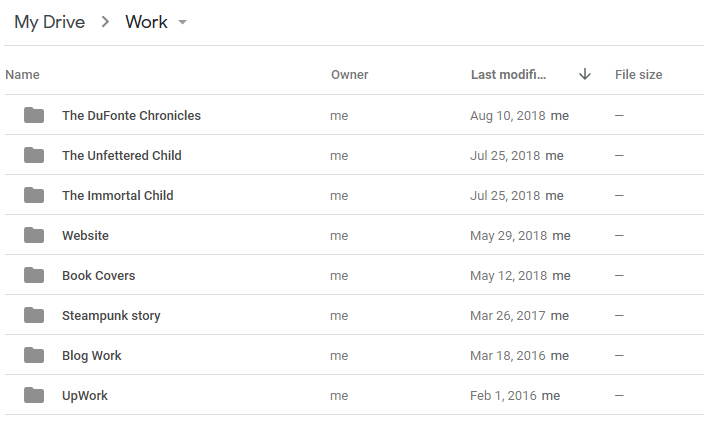No, I’m not talking about Dungeons and Dragons. I’m talking about character sheets for the characters in novels. Not to say that I haven’t used D&D to make characters for my novels, because I certainly have. However, Dungeons and Dragons lacks some very important elements for characters in books.
You want your characters to be memorable. You want them to be believable (at least in some ways). You want them to be unique. How do you go about doing that? Well, I’ll start by telling you how I do it. Then I’m going to share some resources I found to help.
However, since I mentioned resources, I’ll actually start with what I use to outline, keep notes, store information, and begin my writing process. Google Docs! Why do I choose Google Docs? Because it’s easy, it’s organized, and I can access it anywhere I want.
The hitch is the internet requirement for using Docs, and it’s true, it’s quite painful to not have access to my documents when I’m not connected to the Interwebs. With that said, I only work when I’m at a computer, and I rarely am not connected.

What you see above is the spine of my projects, with each folder being the start of a project I’m working on. Within each of these, I keep the main body of the work, broken down by chapters, and then I have a folder as well that contains notes. It’s in the notes folder that I keep my character sheet.
Now for the structure of my character sheet, or what I prefer to call my Character Portrait. I start with the name. That’s kind of a given. Then I go into physical appearance, but I don’t go into great detail here. Instead, I focus on defining traits. For example, Samara’s people are of a darker complexion like that of the Chinese or Mongolians; however, Samara is paler than most of her kind. Also, she has abnormal, night-blue eyes, almost black, whereas most of her people have brown or hazel eyes.
Next, I focus on the character’s history. Why history over personality? Because history, more often than not, shapes personality. Samara’s people are nomads. Life is difficult for them, and they rely heavily on one another. Therefore, Samara is very selfless, willing to stand up for others. She was also being trained as an apprentice by the tribe’s shaman. She is very devoted to her studies, very curious, and intelligent. When she learns magic, it is with determination and relentless persistence.
After history, I focus on the character’s interests before and during the story (sometimes they can change). I also put notes of significant research in the document. For example, I have extensive notes on childhood trauma and how children are affected by and deal with it.
That’s it. I have extensive write-ups for each of these sections. I don’t spend a whole lot of time developing every little detail of the character, that usually just pops in while I’m writing, and I can fill that stuff into my notes later. However, I still do make D&D character sheets, because it’s fun.
This may not work for every writer, so I’m going to tell you of some programs that I discovered, and one in particular that I’m interested in. I’m going to try using portions of it on my next project.
Bibisco
Bibisco is a free-to-download program that gives you a bunch of amazing features, and if you donate (at least 12 pounds), you get even more amazing features.
I’m only going to focus on the character sheet portion of this program, but it is worth checking out the rest if you need help organizing things like locations, timeline, architecture, themes, scenes, and chapters.
The first step to creating a character on Bibisco is to click on the characters tab. The program will now have two sections on the main screen: main characters and secondary characters.
On the right side is a button that states “create main character.” Click this and it will ask for your character’s name. Type it in and hit save. This will take you back to the previous screen, but now you will have your character listed underneath the section that says “main character.”
Next, click on that character. Here is what you’ll see:

As you can see you, there are five questions: Who is he/she? How does he/she look? What does he/she think? Where does he/she come from? And, Where does he/she go?
Underneath these questions are more buttons. When you click on them, you are given a more in-depth questionnaire about the character. There are a large number of questions there, so I’m not going to go into each one, but for example, the “physical features” button has questions like, “What does his/her shoulders look like?” Very, very detailed lists.
Other programs
I haven’t looked into the details of these, but I found a list over on www.reedsy.com that talks about several options (paid and free) when it comes to software for novelists. Click the link for more details.
So how about it? Do you find yourself using these programs? Do you think they’re useful? Please comment below, and thank you for reading.
